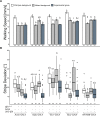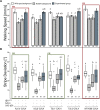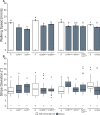Sensitivity to expression levels underlies differential dominance of a putative null allele of the Drosophila tβh gene in behavioral phenotypes
- PMID: 33970909
- PMCID: PMC8136860
- DOI: 10.1371/journal.pbio.3001228
Sensitivity to expression levels underlies differential dominance of a putative null allele of the Drosophila tβh gene in behavioral phenotypes
Abstract
The biogenic amine octopamine (OA) and its precursor tyramine (TA) are involved in controlling a plethora of different physiological and behavioral processes. The tyramine-β-hydroxylase (tβh) gene encodes the enzyme catalyzing the last synthesis step from TA to OA. Here, we report differential dominance (from recessive to overdominant) of the putative null tβhnM18 allele in 2 behavioral measures in Buridan's paradigm (walking speed and stripe deviation) and in proboscis extension (sugar sensitivity) in the fruit fly Drosophila melanogaster. The behavioral analysis of transgenic tβh expression experiments in mutant and wild-type flies as well as of OA and TA receptor mutants revealed a complex interaction of both aminergic systems. Our analysis suggests that the different neuronal networks responsible for the 3 phenotypes show differential sensitivity to tβh gene expression levels. The evidence suggests that this sensitivity is brought about by a TA/OA opponent system modulating the involved neuronal circuits. This conclusion has important implications for standard transgenic techniques commonly used in functional genetics.
Conflict of interest statement
The authors have declared that no competing interests exist.
Figures






Similar articles
-
Flight initiation and maintenance deficits in flies with genetically altered biogenic amine levels.J Neurosci. 2007 Oct 10;27(41):11122-31. doi: 10.1523/JNEUROSCI.2704-07.2007. J Neurosci. 2007. PMID: 17928454 Free PMC article.
-
Tyramine action on motoneuron excitability and adaptable tyramine/octopamine ratios adjust Drosophila locomotion to nutritional state.Proc Natl Acad Sci U S A. 2019 Feb 26;116(9):3805-3810. doi: 10.1073/pnas.1813554116. Epub 2019 Feb 11. Proc Natl Acad Sci U S A. 2019. PMID: 30808766 Free PMC article.
-
Octopamine controls starvation resistance, life span and metabolic traits in Drosophila.Sci Rep. 2016 Oct 19;6:35359. doi: 10.1038/srep35359. Sci Rep. 2016. PMID: 27759117 Free PMC article.
-
Molecular and pharmacological properties of insect biogenic amine receptors: lessons from Drosophila melanogaster and Apis mellifera.Arch Insect Biochem Physiol. 2001 Sep;48(1):13-38. doi: 10.1002/arch.1055. Arch Insect Biochem Physiol. 2001. PMID: 11519073 Review.
-
The control of metabolic traits by octopamine and tyramine in invertebrates.J Exp Biol. 2020 Apr 1;223(Pt 7):jeb194282. doi: 10.1242/jeb.194282. J Exp Biol. 2020. PMID: 32238440 Review.
Cited by
-
Creating Detailed Metadata for an R Shiny Analysis of Rodent Behavior Sequence Data Detected Along One Light-Dark Cycle.Front Neurosci. 2021 Nov 26;15:742652. doi: 10.3389/fnins.2021.742652. eCollection 2021. Front Neurosci. 2021. PMID: 34899155 Free PMC article.
References
-
- Fisher RA. The genetical theory of natural selection. Oxford: Oxford University Press; 1930.
-
- Waxman D, Peck JR. Pleiotropy and the preservation of perfection. Science. 1998;279:1210–3. - PubMed
Publication types
MeSH terms
Substances
LinkOut - more resources
Full Text Sources
Other Literature Sources
Molecular Biology Databases

